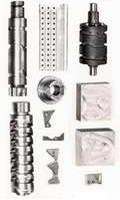www.wimb.net - Numerical Control History
Economic Impact of N/C
Numerical Control is one of today's most dynamic manufacturing processes. Jt is now and will continue to be a boon to metal-cutting industries. The use of N/C for nonmetal cutting processes has also increased phenomenally. Higher production rates and reduced waste have been the claims of most N/C users.
Numerical Control has had a decisive economic impact for the small job-shop as well as the large factory. It is generally estimated that half to three-fourths of all metalworking production runs are "short runs" consisting of only fifty to one-hundred pieces. With the aid of N/C, the small job-shop operator is better able to compete with large manufacturers who use long run production procedures.
Both small and large manufacturers enjoy the profits of Numerically Controlled machining. BQth take advantage of "tying" a Numerical Control system to one or more machine tools. Essentially, their rationale for doing so is centered on the conservation of space, materials, time, energy, and, most important. human resources.
In 1970 it was estimated that in a few years, 75 to 85 percent of the new general purpose machine tools being purchased by industry will be numerically controlled. This estimate includes standard machine tool equipment such as drills, mills, and lathes, but does not take into account the many new industrial applications for numerical control which are in the process of development or which may be anticipated.
A factor which must also be considered in the future use of the numerical control system is the rapid development of low-cost numerical control systems which are available or are being developed. As the machine tool industry grows it is expected that substantial improvements in performance and economics will be designed into new machine tools.
New tools which are rapidly providing the engineers with a more direct route to designing and manufacturing of new products are the computer and additional numerical control systems. Coordinating and expediting these new tools should substan1ially increase efficiency in developing designs for new products.
The computer may be used in the design process and the computer readout from the design may also be used in developing the' numerical control program for the machine tool. The entire design and manufacturing operation may also be automated to the extent that the raw material may be selected from storage and transported to the machine tool shop for processing.
N/C Products

Inspection and packaging may be controlled automatically. These developments are currently a part of the total design and manufacturing process of many of our large aerospace and automotive industries.
Applications of N/C
Numerical control systems have been applied to a wide range of manufacturing machines and processes. Some of the common machines now being assisted by numerical control are drill presses, milling machines, lathes, welders, flame cutting machines, and a host of "special application machines". A multiplicity of processes are expedited through numerical control.
When numerical control was first demonstrated in the early 1950's, a few far-sighted individuals recognized it as a new manufacturing "breakthrough". Indeed it was!
Updated 2007 Oct. 09


